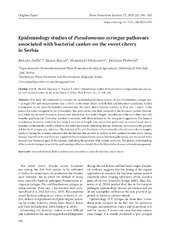Приказ основних података о документу
Epidemiology studies of Pseudomonas syringae pathovars associated with bacterial canker on the sweet cherry in Serbia
| dc.creator | Iličić, Renata | |
| dc.creator | Balaž, Jelica | |
| dc.creator | Ognjanov, Vladislav | |
| dc.creator | Popović Milovanović, Tatjana | |
| dc.date.accessioned | 2023-07-14T07:17:30Z | |
| dc.date.available | 2023-07-14T07:17:30Z | |
| dc.date.issued | 2021 | |
| dc.identifier.issn | 1212-2580 | |
| dc.identifier.issn | 1805-9341 | |
| dc.identifier.uri | https://plantarum.izbis.bg.ac.rs/handle/123456789/702 | |
| dc.description.abstract | This study was conducted to examine the epidemiological characteristics of two Pseudomonas syringae pvs. – syringae (Pss) and morsprunorum race 1 (Psm) on the sweet cherry in both field and laboratory conditions. Cycled inoculations of one-year-old branches indicated that the sweet cherry became sensitive to Psm race 1 earlier in the season (October) compared to Pss (November). The most severe infections occurred in the dormancy period (November), while the necroses formed in January and March were less in their length. Inoculations of the two-/three-year-old branches performed in November resulted in necrosis, with those induced by Pss being more aggressive. The January inoculations, however, resulted in less formed necroses in length. Laboratory tests performed on excised sweet cherry branches confirmed the results yielded by the field experiments, indicating that the dormancy period poses the greatest risk for the P. syringae pvs. infection. The isolation of Pss and Psm bacteria from naturally infected sweet cherry samples (cankers) during the summer indicated that the bacteria that persists in cankers in low numbers became active during autumn. Significant Pss and Psm race 1 epiphytic bacterial populations were noted during the spring, but decreased in the summer and increased again in the autumn, indicating the presence of inoculum reservoirs. The greater understanding of the control strategies aimed at the epidemiological factors should, thus, facilitate better disease outbreak management. | sr |
| dc.language.iso | en | sr |
| dc.publisher | Czech Academy of Agricultural Sciences, Institute of Agricultural and Food Information | sr |
| dc.rights | openAccess | sr |
| dc.rights.uri | https://creativecommons.org/licenses/by-nc/4.0/ | |
| dc.source | Plant Protection Science | sr |
| dc.subject | bacterial dieback | sr |
| dc.subject | field and laboratory inoculation | sr |
| dc.subject | natural infection | sr |
| dc.subject | sweet cherry | sr |
| dc.title | Epidemiology studies of Pseudomonas syringae pathovars associated with bacterial canker on the sweet cherry in Serbia | sr |
| dc.type | article | sr |
| dc.rights.license | BY-NC | sr |
| dc.citation.epage | 205 | |
| dc.citation.issue | 3 | |
| dc.citation.rank | M22 | |
| dc.citation.spage | 196 | |
| dc.citation.volume | 57 | |
| dc.type.version | publishedVersion | sr |
| dc.identifier.doi | 10.17221/140/2020-PPS | |
| dc.identifier.fulltext | http://plantarum.izbis.bg.ac.rs/bitstream/id/2886/bitstream_2886.pdf | |
| dc.identifier.scopus | 2-s2.0-85108709822 | |
| dc.identifier.wos | 000692795700004 |


